Summary
- Victoria has recorded its 11th consecutive 'doughnut day' of no new COVID-19 cases or deaths, as health officials prepare to launch a mass testing blitz in Melbourne’s north and west in a bid to find any remaining infections among 500,000 people.
- NSW has reported its third consecutive day of zero locally acquired cases and Australia has recorded its third consecutive day of no cases of community transmission. But after Victoria's success in containing the virus, NSW now poses a greater COVID-19 risk, experts say.
- Pharmaceutical giant Pfizer says its experimental vaccine is more than 90 per cent effective in preventing COVID-19 based on initial data from a large study, hailing the success a 'great day for science and humanity'.
- Prime Minister Scott Morrison says any vaccine will be made available to Australians, first and foremost, on the basis that it is safe. He says the risk going forward for Australia with the pandemic is two-fold - 'that we take the success for granted and fall back into old habits' and 'people coming back from overseas'.
- The coronavirus supplement for people on JobSeeker will be extended until March – it was due to end at Christmas – but it will fall from $250 to $150 a fortnight.
What you need to know today
If you're just joining us, here are the major developments of the day thus far:
- The announcement from pharmaceutical giant Pfizer and its German partner BioNTech that their coronavirus vaccine appears to be 90 per cent effective has thrilled medical experts and presented a glimmer of hope for people around the world. But it's still much too early to declare the battle against COVID-19 won. Even if the vaccine fully lives up to these preliminary results, challenges in manufacturing and distributing the product loom large.
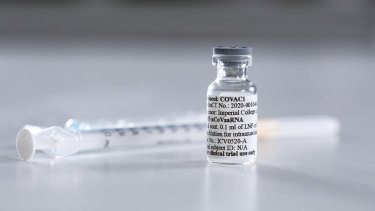
Pfizer could release efficacy data on its vaccine candidate later this month.
- The coronavirus supplement for people on JobSeeker will be extended until March – it was due to end at Christmas – but it will fall from $250 to $150 a fortnight, Prime Minister Scott Morrison announced. It means from January the total fortnightly payment for those who are unemployed will be $715.70.
- Victorians are breathing yet another sigh of relief after the state recorded its 11th consecutive double "doughnut day", with no new COVID cases and no further deaths. There are just four active cases in the state, including one mystery case. Regional Victoria remains COVID free.
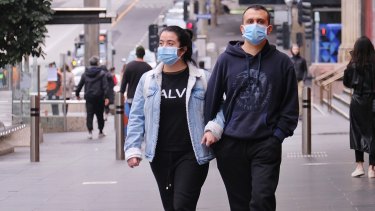
It will be mandatory for Victorians to wear masks outside their homes for the foreseeable future.Credit:Luis Ascui
- NSW has reported its third consecutive day of zero locally acquired cases and Australia is on track to record its third consecutive day of no cases of community transmission.
- In a good sign, Victoria's Chief Health Officer Brett Sutton is taking a week-long holiday. It will be his longest break since January, and Premier Daniel Andrews plans to visit his mum for the first time in almost a year just before Christmas.
- Premier Daniel Andrews has said there will eventually be changes made to mandatory mask rules in Victoria, but only "when it’s safe" to do so.
- Kindergarten will be free for Victorian three- and four-year-old children next year, while 95 per cent of schools will be running before and after school care programs in a bid to help women get back to work.
- Health authorities are preparing to embark on a mass testing blitz in Melbourne's western and northern suburbs in a bid to ensure there are no undetected cases of the virus.
- The ending of Victoria's coronavirus restrictions has been welcomed by a surge in spending across the state, particularly on food services, furniture and household equipment. Spending across Victoria is now 15 per cent up on the same time last year, stronger than NSW (13 per cent) and in line with Queensland.
- Sydney commuters will be able to receive real-time notifications about the capacity of their train service via new technology. The opt-in system will be available to registered Opal card holders who have the Opal app on their mobile phone, and
- Queensland has recorded one new COVID case in hotel quarantine - a woman who has returned from Turkey. The state has reached 55 days of no community transmission.
Latest updates
From the Archives, 1972: Cholera outbreaks in Melbourne and Queensland
On this day in 1972, Australia was dealing with a different kind of disease outbreak.
A cholera outbreak was traced to a Qantas flight from Bahrain and contact tracers were desperately searching for passengers.
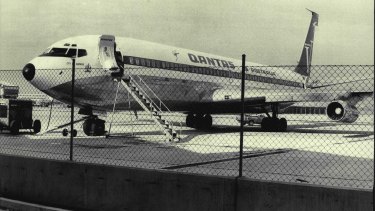
A Qantas jet quarantined in Sydney as the cholera scare spreads in 1972.Credit:Trevor James Dallen
At that stage there were 19 confirmed cholera victims in Australia, including 10 in Victoria. Three other passengers from the flight in hospitals throughout the country were "highly suspected" cholera cases.
In Victoria, another 10 people were in hospital with suspected cholera symptoms.
PM ‘optimistic’ about vaccine rollout
By Josh Dye
Prime Minister Scott Morrison expressed hope that a coronavirus vaccine would be available next year, after pharmaceutical giant Pfizer reported its vaccine appears to be more than 90 per cent effective.
“I don’t want to overstate it, but that is welcome news. It is one of four vaccines that Australia is involved in and these results are very promising. I’m optimistic and hopeful about next year about the rollout of those vaccine programs,” he said.
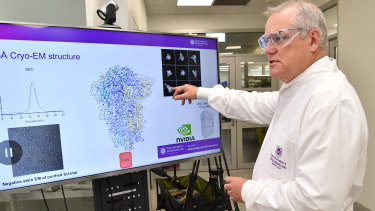
Prime Minister Scott Morrison during a tour of the University of Queensland's vaccine lab in Brisbane last month.Credit:AAP
“The vaccines that will be made available to Australians will be done so, first and foremost, on the basis that they are safe.”
Mr Morrison also welcomed the news Australia had recorded three consecutive days of no local community transmission.
“The risk going forward for us with the pandemic is two-fold. That we take the success for granted and fall back into old habits,” he said. “The other risk of course is people coming back from overseas.”
Where are Victoria's four active cases?
There are just four active coronavirus cases in Victoria today, including one mystery case with no known source of infection.
Two active cases remain in the Greater Dandenong council area that takes in suburbs including, Springvale, Keysborough, Noble Park, Dandenong and Lyndhurst.
There is one active case in the Casey council area (Berwick, Clyde, Cranbourne, Hallam, Hampton Park) and one active case in the Monash council area (Glen Waverley, Hughesdale, Oakleigh, Oakleigh East, Wheelers Hill).
None of the active cases are in healthcare workers.
Victoria by the numbers
Victoria's Department of Health and Human Services has released its daily COVID-19 update.
"This is the 11th straight day where Victoria has recorded zero daily new cases or deaths," it reads.
The rolling 14-day case average for metropolitan Melbourne is 0.4 cases per day, while regional Victoria remains COVID free.
Two people are in hospital fighting the virus, but fortunately, no COVID patients are in intensive care.
Nearly 13,000 tests (12,955 to be exact) were carried out yesterday.
Since the pandemic started:
- 4277 Victorian cases may indicate community transmission – no change since yesterday
- 19,522 people have recovered from the virus
- 18,953 cases are from metropolitan Melbourne, while 1197 are from regional Victoria
- 9702 men and 10,630 women have contracted the virus
- 3574 healthcare workers have been infected
- More than 3.3 million coronavirus tests have been carried out
Morrison confirms JobSeeker rate to be slashed by $100
By Josh Dye
Prime Minister Scott Morrison has confirmed an extension to the temporary JobSeeker supplement welfare payment through to the end of March. The payments were due to end at Christmas.
“We will be extending that supplement for the three months after the end of December,” Mr Morrison said at his press conference today.
“We will be changing the rate of that supplement down to $150 for that period out to the end of three months and this will come at a cost to taxpayers of some $3.2 billion over that three-month period.”
It means from January the total fortnightly payment for those who are unemployed will be $715.70. People whose partners are earning up to $80,000 per year will still be able to access the payment.
JobSeeker supplement to be extended until end of March
By David Crowe
Unemployed Australians will have the temporary coronavirus supplement extended into next year at a reduced rate under a federal government decision to increase the $16.8 billion payment.
The supplement will continue until March in a boost for JobSeeker recipients and others on income support, ending weeks of doubt over whether the payments would end as scheduled at Christmas.

Massive lines outside Centrelink offices in Melbourne in March.Credit:Jason South
Prime Minister Scott Morrison and cabinet ministers made the decision on Monday night and are expected to confirm it on Tuesday, with the rate likely to fall from $250 to $150 per fortnight.
The continued payments are likely to be welcomed but the move delays a bigger decision on the permanent rate for the JobSeeker allowance, which offers $565.70 a fortnight.
Australian Council of Social Service chief Cassandra Goldie has been calling on the government to increase the base rate to keep families out of poverty, but ministers have pushed that decision to next year.
Social Services Minister Anne Ruston said two months ago the government would decide any extension of the temporary supplement closer to Christmas.
Labor social services spokeswoman Linda Burney said the base rate needed to increase, as she pointed to calls from ACOSS and the Business Council of Australia for the change.
"We believe that the supplement should stay in place at the current rate of $250 until at least the end of March," Ms Burney told ABC Radio National on Tuesday.
"There needs to be a decision by this government. And I'm just astounded that they have not announced a permanent increase."
Watch live: PM and NSW Premier press conferences
NSW high-risk exposure sites
No further places have been added to the list of high-risk exposure sites in NSW today, with the state recording zero cases of local transmission. Here's the existing list:
Victorian Premier to see his mum for the first time in almost a year, just before Christmas
By Sumeyya Ilanbey
Victorian Premier Daniel Andrews says he will visit his mum he hasn’t seen in almost a year when he heads home to Wangaratta just before Christmas.
“Cath and I and the kids will get up there before Christmas again, so I’m not quite sure when it’ll be, but we’d go sooner but it’s pretty busy at the moment, obviously,” the Premier said.
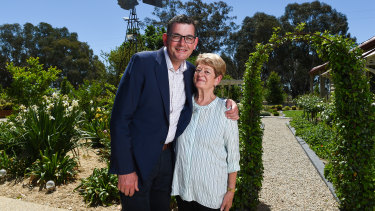
Daniel Andrews with his mum Jan at her home in Wangaratta.Credit:AAP
“And it’s a reasonable drive and of course once you go you probably stay and it just becomes a two- or three-day thing.”
The Premier’s mum, Jan Andrews, called ABC Radio on Saturday, October 31 - the first break in three months the Premier took from daily coronavirus briefings.
Speaking to host Libby Gore, she reflected on her son’s time in the spotlight.
“I have watched every press conference,” Ms Andrews said.
“And some days I have thought, ‘yes, you look OK’, the other days I’ve thought ‘oh Daniel, you’re looking very tired’. But he’s strong.”
On his mum’s own time in the spotlight, Mr Andrews, tongue-in-cheek, said: “She thought it was good on the first day that I didn’t do media for 120 days – she would. That’s what mums are like. She’s a great person.”
The Age's view: Victoria's recovery push should target those most in need
"You can't fix the financial crisis until you fix the health crisis." It's a mantra that has often been voiced by many a political leader, including Victorian Premier Daniel Andrews.
Let me draw your attention to today's editorial in The Age where we look at Andrews' promises to spend big come budget time.
The Morrison government has already used the federal budget to spend up big, and Mr Andrews has flagged a similar approach, promising the “biggest and most significant” budget in Victoria's history. The big question is: on what?
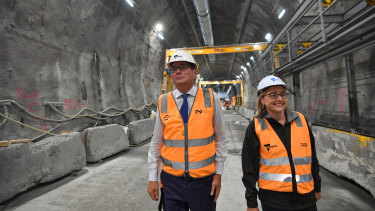
Daniel Andrews needs to look beyond big infrastructure projects. Credit:Joe Armao
Before the pandemic, the Victorian government was well under way on multibillion-dollar infrastructure projects, including the Metro Tunnel rail link and the West Gate Tunnel, had started preliminary work on the North East Link, and was in the planning phase for the airport rail link and the Suburban Rail Loop.
The three biggest projects – the North East Link, West Gate Tunnel and Metro Tunnel rail link – will between them cost at least $11 billion more than originally promised.
This week, a Grattan Institute report raised serious concerns about the viability of such large projects, warning they could turn into white elephants, and in some instances had been poorly planned and implemented, leading to the cost blowouts.
"Taxpayers would get a bigger bang for their buck if politicians steered clear of what they like to call 'nation-building' and 'city-shaping' mega-projects, and instead spent more on upgrading existing infrastructure and on social infrastructure such as aged care and mental health care," the report's lead author, Marion Terrill, said.
Mr Andrews has been adamant that science was the guiding principle in containing the virus. Now in economic repair mode, the Premier needs to ensure that his guiding principle is how to stimulate the economy quickly, and fairly.
Australia could learn from Singapore's plan to reopen to international travellers
By Michael Gebicki
We're hearing it's nearly impossible to book beachside accommodation for Christmas in Victoria now that Melbourne's "ring of steel" as been removed and the city is emerging from its tough stage four lockdown. Well, perhaps Singapore could be on the cards?
Singapore is embarking on a suite of controlled measures aimed at reopening the country to international travellers in a program that could provide a template for Australia's own re-emergence on the international travel scene.
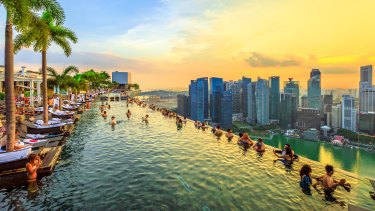
Infinity Pool of Skypark that tops the Marina Bay Sands Hotel and Casino in Singapore.Credit:Shutterstock
While Singapore has been one of the countries least affected by the COVID-19 health crisis, with a death rate far lower than Australia's despite double the case numbers, the island-state's economy has been shattered.
Singapore's tourism industry has not been spared. Tourist arrivals were just 9500 in September 2020. That's a drop of 99.4 per cent on the figure recorded in September 2019.
With caution at the forefront, Singapore has embarked on a pump-priming exercise, allowing in travellers from countries with low rates of COVID-19, and under strict conditions.
Singapore now allows residents of Australia, Brunei, Vietnam and New Zealand to apply for an Air Travel Pass (ATP).
The ATP allows any traveller from those countries to make a short-term visit to Singapore. In the case of Australian residents, apart from remaining in Australia for 14 days before departure for Singapore, submitting a health declaration and downloading Singapore's TraceTogether app to their smartphone, the main requirement is a polymerase chain reaction (PCR) test to be taken on arrival in Singapore, and a stay in isolation in pre-booked accommodation for up to two days awaiting the result of their test. The PCR test is the gold standard assessment for COVID-19, more accurate than an antigen test, but also slower and more expensive.
If the Australian government wants to start opening the door to international travellers, allow its own residents to depart and return while protecting the health of the wider community and stop its outbound tourism industry from falling into the gutter and all its employees joining the ranks of the unemployed, it would do well to pay attention to Singapore in the days ahead.
Most Viewed in National
https://news.google.com/__i/rss/rd/articles/CBMizwFodHRwczovL3d3dy5zbWguY29tLmF1L25hdGlvbmFsL2Nvcm9uYXZpcnVzLXVwZGF0ZXMtbGl2ZS1tYXNzLXRlc3RpbmctYmxpdHotaW4tbWVsYm91cm5lLXN1YnVyYnMtbnN3LXBvc2VzLWdyZWF0ZXItcmlzay1hcy12aWN0b3JpYS1yZW9wZW5zLXBmaXplci12YWNjaW5lLW1vcmUtdGhhbi05MC1wZXItY2VudC1lZmZlY3RpdmUtMjAyMDExMTAtcDU2ZDFsLmh0bWzSAc8BaHR0cHM6Ly9hbXAuc21oLmNvbS5hdS9uYXRpb25hbC9jb3JvbmF2aXJ1cy11cGRhdGVzLWxpdmUtbWFzcy10ZXN0aW5nLWJsaXR6LWluLW1lbGJvdXJuZS1zdWJ1cmJzLW5zdy1wb3Nlcy1ncmVhdGVyLXJpc2stYXMtdmljdG9yaWEtcmVvcGVucy1wZml6ZXItdmFjY2luZS1tb3JlLXRoYW4tOTAtcGVyLWNlbnQtZWZmZWN0aXZlLTIwMjAxMTEwLXA1NmQxbC5odG1s?oc=5
2020-11-10 01:40:00Z
52781177985680
Bagikan Berita Ini














0 Response to "Coronavirus updates LIVE: Victoria records zero cases for 11 consecutive days, Sydney commuters to be alerted about full trains, Pfizer vaccine 'more than 90 per cent effective' - The Sydney Morning Herald"
Post a Comment